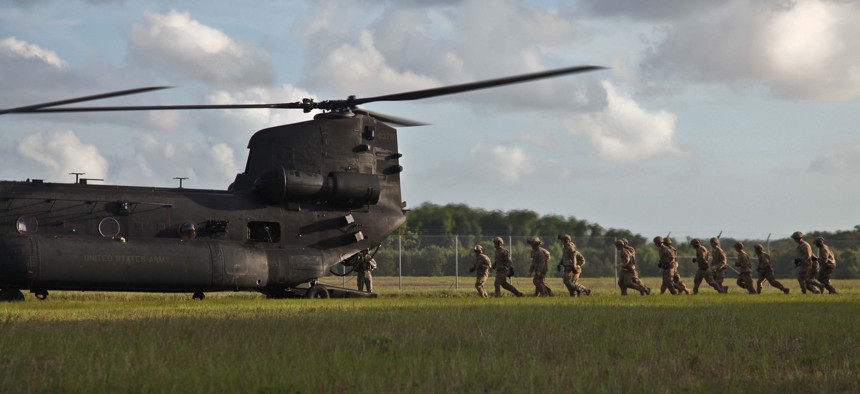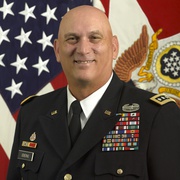
Army Rangers of 1st Battalion, 75th Ranger Regiment, prepare to enter an MH-47 helicopter to execute fast rope training at Hunter Army Airfield, Ga. June 2, 2014. US. Army Photo by Spc. Coty Kuhn/Released
Force 2025 and Beyond: How the Army Is Preparing for Its Future
Over the past year, the Army has refined its vision, its operating concept, and its strategy for comprehensive change. Here’s how they all fit together.
The velocity of instability continues to increase worldwide: ISIL and terrorism in Iraq, Syria, and Yemen; anarchy and extremism in North Africa; Russian annexation of Crimea and the use of unconventional land forces in Ukraine; provocation by North Korea; and various emergencies requiring complex humanitarian assistance and disaster relief efforts. Global instability, coupled with the reduction in military capabilities of many of our allies, has emboldened potential adversaries and magnified the risk to U.S. interests around the world. It is therefore imperative, now more than ever, to field a ready and modern Army that is innovative and adaptive and that remains the bedrock of the Joint Force.
The Army is meeting this challenge — to change itself and improve land power capabilities — through a strategy called Force 2025 and Beyond. It is our method to prepare the Army for the complexities of the global security environment, both now and in the future. Over the past year, the Army has refined this strategy and its underpinnings; here’s how they all fit together.
In May, the Army released its updated Army Vision, Strategic Advantage in a Complex World, to be the intellectual foundation for its efforts to prevent conflict, shape security environments, and win wars. That followed the October release of the new Army Operating Concept, Win in a Complex World, which discusses how warfighting capabilities combine to fulfill larger missions — that is, how future Army forces, as part of joint, interorganizational, and multinational efforts, will operate to accomplish campaign objectives and protect U.S. national interests. Force 2025 and Beyond, in turn, shapes the comprehensive effort necessary to achieve the capabilities envisioned in the Army Operating Concept.
Force 2025 and Beyond supports decisions at every step, from concept and capability development to resource investments and fielding. It offers a framework, based on the Army Vision and Army Operating Concept, to evaluate ideas for force development — and the assumptions on which they are based. It allows Army and civilian leaders alike to properly invest resources in order to adapt, evolve, and innovate. And it synchronizes processes, products, and concepts, and translates them into warfighting capabilities.
In short, Force 2025 and Beyond is a holistic and evolutionary approach to develop landpower concepts and capabilities for the Joint Force and integrate them across doctrine, organizations, training, materiel development, leadership and education, personnel, and facilities (DOTMLPF).
Among its organizing initiatives are the Army Warfighting Challenges, a set of enduring first-order problems whose solutions will improve current and future force combat effectiveness. These provide the analytical framework to integrate efforts across warfighting functions and allow collaboration with key stakeholders in learning activities, modernization, and future force design.
Another is the Force 2025 Maneuvers, which execute the important learning activities that help leaders integrate future capabilities and develop interim solutions to warfighting challenges. They provide the evolutionary and innovative framework for DOTMLPF objectives, leader and soldier assessment tools, and policy solutions to achieve the full range of capabilities envisioned in the Army Operating Concept. They enable the Army, for example, to consider logistics, demand reduction, the integration of robotics and autonomy-enabled systems, and leader, soldier, and team optimization as we improve the future force.
Yet another key component is the Army Warfighting Assessment, which replaces one of our two Network Integration Evaluations conducted each year. It offers a thorough and innovative capstone exercise that allows the Army to experiment, assess, and test new concepts and capabilities.
Over the next five years, the Army will focus on adapting while maintaining and improving upon current functionality. As we modify existing capabilities, we must balance force structure, readiness, and modernization. We must also respond to resource constraints, to shifts in missions and operating environments, to the ease and speed of technology transfers, and to the reality that we must outpace our enemies and adversaries, who are exceedingly adaptive. So the Army must realize DOTMLPF solutions faster than in the past to ensure our competitive advantage through the development of adaptive leaders and the integration of advanced technologies with skilled soldiers and well-trained teams.
Over the next 10 years, the Army will focus on solutions that provide multiple options to respond to and resolve crises. We will continue to conduct joint combined arms maneuver from multiple locations and domains to present multiple dilemmas to the enemy, while ensuring that joint, interorganizational, and multinational teams stand ready to seize, retain, and exploit the initiative.
Beyond the next decade, the Army will balance near-term requirements with smart and prudent investments that support innovation and modernization, and that prioritize promising technologies. Army research and development will work in concert with our partners in industry to maintain candidate technologies that have the greatest potential to respond to warfighting challenges and capability gaps, and that best position us to anticipate and thrive within an ever-evolving global security environment.
Force 2025 and Beyond is already assessing key capabilities such as manned-unmanned teaming, operational energy, robotics and autonomous systems, and expeditionary command posts. Innovative efforts are focused on challenges ranging from shaping the security environment, to countering weapons of mass destruction, to conducting space and cyber operations, to integrating and delivering fires, to exercising mission command. Force 2025 and Beyond efforts have led to a comprehensive Combat Vehicle Modernization Strategy that balances near-term operational requirements with the warfighting demands of the future battlefield and a better understanding of the design principles needed to guide future force development. They have developed an overall vision that addresses all echelons, including the enterprise level of the network, and that describes in operational terms how the mission command network will enable the force when at home station, en route, and deployed.
Force 2025 and Beyond will ensure that the Army achieves overmatch through powerful combinations of dynamic and adaptive leadership, competent and committed soldiers, and innovative concepts and technologies. By enabling collaboration and analytical rigor, it will continue to help Army leaders anticipate the demands of future armed conflict through a better understanding of continuities in the nature of war and an appreciation for changes in the character of armed conflict.
Taken together, the Army Vision, Army Operating Concept, and Force 2025 and Beyond provide the framework and strategy for the Army to adapt, evolve, and innovate; to meet the needs of the future operational environment; and to prevent conflict, shape security environments, and win in a complex world today, tomorrow, and in the years ahead.




